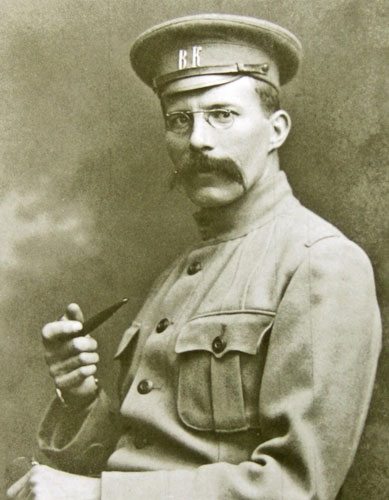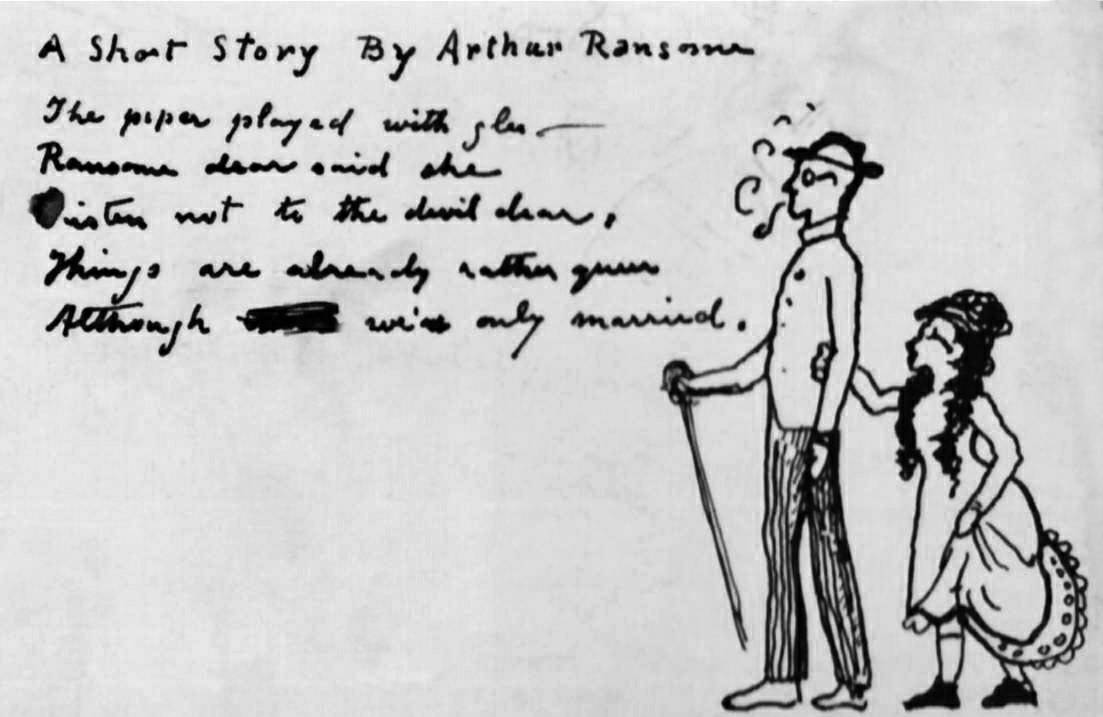|
Arthur Ransome and Pamela Colman
Smith

Arthur Ransome in his Press
Corps Uniform during World War I
Arthur Mitchell Ransome
(1884-1967) was an
English author
and journalist, best known for
writing the
Swallows and Amazons
series of children's books.
These tell of school-holiday adventures of
children, mostly in the
Lake District and
the Norfolk Broads. Many of the books involve sailing, fishing, camping and
other common subjects of interest to boys. The books remain so popular that they
provide a basis for a whole tourist industry around
Windermere
and
Coniston Water —
the two lakes that Ransome used as the basis for
his fictional North Country lake.
As a young man he also wrote about
the literary life of London; a few years later he wrote about life in Russia
just before, during, and after the March and October Revolutions of 1917. Some
years after his death, information was revealed that he had worked as a spy for
the British Secret Intelligence Service (SIS, aka MI6) while working as a
journalist in Soviet Russia.
In the 1904-1906 time frame, he
was involved with the London bohemian literary and artistic communities. In
1907, when he was only 23, he published a book which related his London
experiences entitled Bohemia in London. In the chapter entitled "A Chelsea Evening,"
Ransome relates some fascinating though
rather over-romanticized accounts of bohemian activities in that city. In that
chapter tells about his attendance at some of the open house parties given by
Pamela "Pixie" Colman Smith. Ransome refers to Pixie Smith under the
fictionalized name of "Gypsy." The following is an excerpt from that chapter:
"We set off together down the Fulham
Road, in the most beautiful light of a summer evening. ... At last we turned to
the right, between houses with narrow gardens and little trees in front of them,
and then to the right again, till we stopped at the end of a short street. " Her
name is Gypsy," he said dramatically. "No one ever calls her anything else."
Then he swung open the garden gate, walked up the steps of the house, and
knocked vigorously on the door. ... Someone broke off in a song inside, and
quick steps shuffled in the passage. The door was flung open, and we saw a
little round woman, scarcely more than a girl, standing in the threshold. She
looked as if she had been the same age all her life, and would be so to the end.
She was dressed in an orange-coloured coat that hung loose over a green skirt,
with black tassels sewn all over the orange silk, like the frills on a red
Indian's trousers. She welcomed us with a little shriek. It was the oddest, most
uncanny little shriek, half laugh, half exclamation. It made me very shy. It was
obviously an affectation, and yet seemed just the right manner of welcome from
the strange little creature, " goddaughter of a witch and sister to a fairy,"
who uttered it. She was very dark, and not thin, and when she smiled, with a
smile that was peculiarly infectious, her twinkling gypsy eyes seemed to vanish
altogether. ... "Come in!" she cried, and went shuffling down the passage in
that heavy parti-coloured dress.
"We left our hats and followed her into a mad room out of a fairy tale. As soon
as I saw it I knew she could live in no other. It had been made of two smaller
chambers by the removal of the partition wall, and had the effect of a
well-designed curiosity shop, a place that Gautier would have loved to describe.
The walls were dark green, and covered with brilliant-coloured drawings,
etchings, and pastel sketches. A large round table stood near the window, spread
with bottles of painting inks with differently tinted stoppers, china toys,
paperweights of odd designs, ashtrays, cigarette boxes, and books; it was lit up
by a silver lamp, and there was an urn in the middle of it, in which incense was
burning. A woolly monkey perched ridiculously on a pile of portfolios, and
grinned at the cast of a woman's head, that stood smiling austerely on the top
of a black cupboard, in a medley of Eastern pottery and Indian gods. The
mantel-shelves, three stories high, were laden with gimcracks. A low bookcase,
crammed and piled with books, was half hidden under a drift of loose pieces of
music. An old grand piano, on which two brass bedroom candlesticks were burning,
ran back into the inner room, where in the darkness was a tall mirror, a heap of
crimson silks, and a low table with another candle flickering among the bottles
and glasses on a tray. Chairs and stools were crowded everywhere, and on a big
blue sofa against the wall a broadly whiskered picture-dealer was sitting,
looking at a book of Japanese prints. ...
"Just then there was another tap, and two women came in together. The first was
a tall, dark Scottish girl, with a small head and a beautiful, graceful neck,
very straight and splendid (I called her the Princess at once in my fantastic
boyhood), and the other a plump, jolly American. ...
" ... When everybody had their glasses, Gypsy came back into the front part of
the room, and, sitting in a high-backed chair that was covered with gold and
purple embroideries, she cleared her throat, leaned forward so that the
lamplight fell on her weird little face, and sang, to my surprise, the old
melody:
"O the googoo bird is a giddy bird,
No other is zo gay.
O the googoo bird is a merry bird,
Her zingeth all day.
Her zooketh zweet flowers
To make her voice clear,
And when her cryeth googoo, googoo,
The zummer draweth near.
" ... After that she chanted in a monotone one of the poems from Mr. Yeats's "
Wind Among the Reeds: "
"I went out into the hazel wood,
Because a fire was in my head,
And cut and peeled a hazel wand,
And hooked a berry to a thread."
And then the stately Scottish girl [Nona Stewart] sat down at the old piano, and
after playing an indolent little melody over the faded yellow keys, brought out
in tinkling sweetness the best of all the songs that have ever come to London
from the sea. Nearly all the company knew it by heart and sang together :
"Farewell and adieu to you, fair Spanish ladies,
Adieu and farewell to you, ladies of Spain ;
For we've received orders for to sail for Old England,
And we may never see you, fair ladies, again.
"So we'll rant and we'll roar, like true British sailors,
We'll range and we'll roam over all the salt seas,
Until we strike anchor in the channel of Old England ;
From Ushant to Scilly 'tis thirty-five leagues.
" ... Presently the American girl [Peggy Cole, wife of American painter Alphaeus Cole]
begged for a story. Gypsy had spent some part of her life in the Indies, and
knew a number of the old folk tales, of Annansee the spider, another Brer Rabbit
in his cunning and shrewdness, and Chim Chim the little bird, and the singing
turtle, and the Obeah Woman, who was a witch, "wid wrinkles deep as ditches on
her brown face." She told them in the old dialect, in a manner of her own.
Fastening a strip of ruddy tow about her head, so that it mingled with her own
black hair, she flopped down on the floor, behind a couple of lighted candles,
and, after a little introductory song that she had learned from a Jamaican
nurse, told story after story, illustrating them with the help of wooden toys
that she had made herself. She told them with such precision of phrasing that
those who came often to listen soon had them by heart, and would interrupt her
like children when, in a single word, she went astray. To hear her was to be
carried back to the primitive days of story-telling, and to understand, a
little, how it was that the stories of the old minstrels were handed on from man
to man with so little change upon the way.
"That was my first evening of friendliness in Chelsea. ... "
| Ransome became a big fan of
Pixie Smith's story telling and was a regular visitor to her weekly parties; his
name appears frequently in Smith's Visitors Book, which she kept to provide a
record of the attendance at her parties. The pictorial entry shown at the right
was sketched in the book by Ransome during a visit in 1904. The "short
story" is rather fanciful as he did not marry (to Ivy Constance Walker)
until 1909. This Visitors Book was acquired
by the noted Tarot Deck collector and founder of U.S. Games Systems, Inc. of
Stamford, Connecticut, Stuart R. Kaplan. He has stated that the book is more
than 150 pages in length and spans the 1901-1905 time frame. Among the well
known artists who attended her weekly parties were: Irish poet William Butler
Yeats (1865-1939); his brother and writer John "Jack" Butler Yeats (1871-1957);
English composer Martin Edward Fallas Shaw (1875-1958); Japanese writer and
illustrator Yoshio Markino (1869-1956); lesbian writer Christopher St. John
whose real name was Christabel Marshall (1873-1060); Scottish novelist and
playwright Sir James Matthew Barrie (1860-1937), the creator of Peter Pan;
American artist Alphaeus Philemon Cole (1876-1988) and his wife Margaret "Peggy"
Cole (died 1961); and the English poet John Masefield (1878-1967), the Poet
Laureate of the United Kingdom from 1932 until 1967.
|
 |
References: 1)
Stuart R. Kaplan, The Artwork and Times of Pamela Colman Smith (2009), pages 68-72.
2) Arthur Ransome,
Bohemia in London
(1907), chapter entitled "A Chelsea Evening," pages 55-64.
|